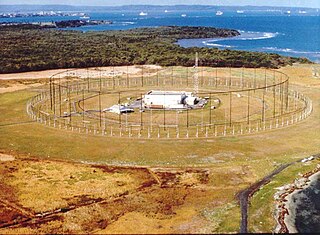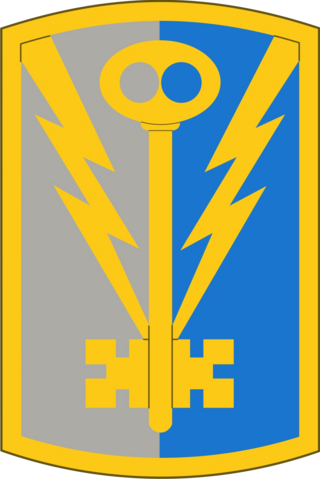
Arlington Hall is a historic building in Arlington, Virginia. Originally it was a girls' school and later the headquarters of the United States Army's Signal Intelligence Service (SIS) cryptography operations during World War II. The site houses the George P. Shultz National Foreign Affairs Training Center and the Army National Guard's Herbert R. Temple Jr. Readiness Center. It is located on Arlington Boulevard between S. Glebe Road and S. George Mason Drive.

Royal Air Force Menwith Hill is a Royal Air Force station near Harrogate, North Yorkshire, England, which provides communications and intelligence support services to the United Kingdom and the United States. The site contains an extensive satellite ground station and is a communications intercept and missile warning site. It has been described as the largest electronic monitoring station in the world.

The Federal Intelligence Service is the foreign intelligence agency of Germany, directly subordinate to the Chancellor's Office. The BND headquarters is located in central Berlin. The BND has 300 locations in Germany and foreign countries. In 2016, it employed around 6,500 people; 10% of them are military personnel who are formally employed by the Office for Military Sciences. The BND is the largest agency of the German Intelligence Community.

A circularly disposed antenna array (CDAA), sometimes referred to as a circularly disposed dipole array (CDDA) or a wullenweber, is a large circular antenna array used for radio direction finding. They are used by military and government agencies to triangulate radio signals for radio navigation, intelligence gathering, search and rescue, and enforcement of broadcasting laws. Because their huge circular reflecting screens look like circular fences, some antennas have been colloquially referred to as "elephant cages". The term "wullenweber" was the World War II German cover term used to identify their secret CDAA research and development program; its name is unrelated to any person involved in the program.

The United States Army Security Agency (ASA) was the United States Army's signals intelligence branch from 1945 to 1977. The Latin motto of the Army Security Agency was Semper Vigilis, which echoes the declaration, often mistakenly attributed to Thomas Jefferson, that "The price of liberty is eternal vigilance."

Known as "INSCOM's Contingency Force", the 297th Military Intelligence Battalion is a battalion subordinate to the 513th Military Intelligence Brigade, located at Fort Eisenhower, Georgia. Its mission is to provide operational, all source intelligence to the Commander, U.S. Army Central Command (CENTCOM). Battalion intelligence operations include all source analysis, collection management, battlefield damage assessment, imagery exploitation and dissemination. The battalion sustains itself and the Brigade Headquarters by providing food service, maintenance, military police and communications support.
Camp King is a site on the outskirts of Oberursel, Taunus, with a long history. It began as a school for agriculture under the auspices of the University of Frankfurt. During World War II, the lower fields became an interrogation center for the German Air Force. After World War II, the United States Army also used it as an interrogation center and intelligence post. The United States CIA used the site to test drugs including LSD on prisoners as part of Project BLUEBIRD, the predecessor to MKUltra. In 1968, it became the command and control center for the United States Army Movements Control Agency - Europe (USAMCAEUR). Today it has been rebuilt as a German housing area.

The 719th Military Intelligence Battalion, operates a partial strategic/partial tactical mission. The battalion is located at Zoeckler Station, a sub-installation of Camp Humphreys, Republic of Korea. It is subordinate to the 501st Military Intelligence Brigade and has three subordinate companies, A Co, B Co and HHSC.

The 501st Military Intelligence Brigade is a United States Army unit, assigned to the United States Army Intelligence and Security Command (INSCOM) under the operational control of United States Forces Korea (USFK) located in South Korea. The 501st MI Brigade conducts theater level multi-discipline intelligence collection and analysis, aerial Intelligence Surveillance & Reconnaissance (ISR), and security operations in support of Eighth United States Army, U.S. Army Pacific, U.S. Pacific Command, U.S. Forces Korea, and other national level agencies.

The United States Army Intelligence and Security Command (INSCOM) is a direct reporting unit that conducts intelligence, security, and information operations for United States Army commanders, partners in the Intelligence Community, and national decision-makers. INSCOM is headquartered at Fort Belvoir, Virginia.

The Bad Aibling Station (BAS), also known as the 18th United States Army Security Agency Field Station, Field station 81, and Hortensie III is a satellite tracking station operated by the German SIGINT agency BND from nearby Mangfall Barracks in Bad Aibling, Bavaria.
Gablingen Kaserne is a former military facility in Gablingen near Augsburg, Germany, which was closed in 1998. Its primary use was signals intelligence collection during the Cold War.

The 500th Military Intelligence Brigade is a unit of the United States Army and subordinate to the U.S. Army Intelligence and Security Command. Its mission is to provide tailored, multi-disciplined intelligence and intelligence capabilities in support of USARPAC and other Commands, to defeat adversaries, promote regional stability, support partners and allies, and protect US interests. The 500th is headquartered at Schofield Barracks, Hawaii.
Vint Hill Farms Station (VHFS) was a United States Army and National Security Agency (NSA) signals intelligence and electronic warfare facility located in Fauquier County, Virginia, near Warrenton. VHFS was closed in 1997 and the land was sold off in 1999. Today the site hosts various engineering and technology companies, as well as two Federal Aviation Administration (FAA) air traffic control facilities, and the Cold War Museum.

The AN/FLR-9 is a type of very large circularly disposed antenna array, built at eight locations during the Cold War for HF/DF direction finding of high priority targets. The worldwide network, known collectively as "Iron Horse", could locate HF communications almost anywhere on Earth. Because of the exceptionally large size of its outer reflecting screen, the FLR-9 was commonly referred to by the nickname "Elephant Cage." Constructed in the early to mid 1960s, in May 2016 the last operational FLR-9 at Joint Base Elmendorf-Richardson in Alaska was decommissioned. It can be confused with the US Navy's AN/FRD-10, which also used a circularly disposed antenna array.

The Dagger Complex is a US military base in Darmstadt (Germany), close to Griesheim and located at the Eberstädter Weg, south of the August-Euler-Airfield.

The 308th Military Intelligence Battalion is an active duty Military Intelligence (MI) Battalion of the United States Army assigned to the 902nd MI Group, an Intelligence & Security Command (INSCOM) subordinate.

The 311th Military Intelligence Battalion is an active duty Military Intelligence (MI) Battalion of the United States Army stationed at Camp Zama, Japan and assigned to the 500th MI Brigade. The 311th MI Battalion is equipped to continue to provide support and train alongside U.S. Army Japan partner units, and Japan Ground Self-Defense Force coalition partners. The 311th conducts continuous multi-discipline Intelligence operations in support of U.S. Army Pacific operations and national level requirements in the U.S. Indo-Pacific area of operations.

The 203rd Military Intelligence Battalion (Technical Intelligence) is the sole technical intelligence (TECHINT) collection and foreign material exploitation unit of the United States Department of Defense and a battalion in the United States Army Reserve. The 203rd obtains and exploits captured enemy materials, maintains one of the premier test and evaluation inventories of adversary equipment and weaponry in the US military, and supports specialized tasking including counter-terrorism, special reconnaissance, and direct action missions. Much of the units work is conducted in close collaboration with the National Ground Intelligence Center. The battalion's intelligence products provide TECHINT support to INSCOM, the Defense Intelligence Enterprise, the broader US Intelligence Community (IC), the Five Eyes, NATO, and foreign allies and partners.

The United States Army Geospatial Intelligence Battalion, previously known as the 3rd Military Intelligence Center, is a military intelligence battalion specializing in the production and exploitation of geospatial intelligence (GEOINT), and the only operational military command at the National Geospatial-Intelligence Agency (NGA). Co-located within the NGA headquarters (NGA-East) on Fort Belvoir in Springfield, Virginia, the unit produces and analyzes geospatial intelligence products for ground combat forces in close collaboration with its host agency and other members of the U.S. Intelligence Community. Though colocated with NGA, the AGB differs from NGA's own Support Teams in that it receives tasking from the Army.


















